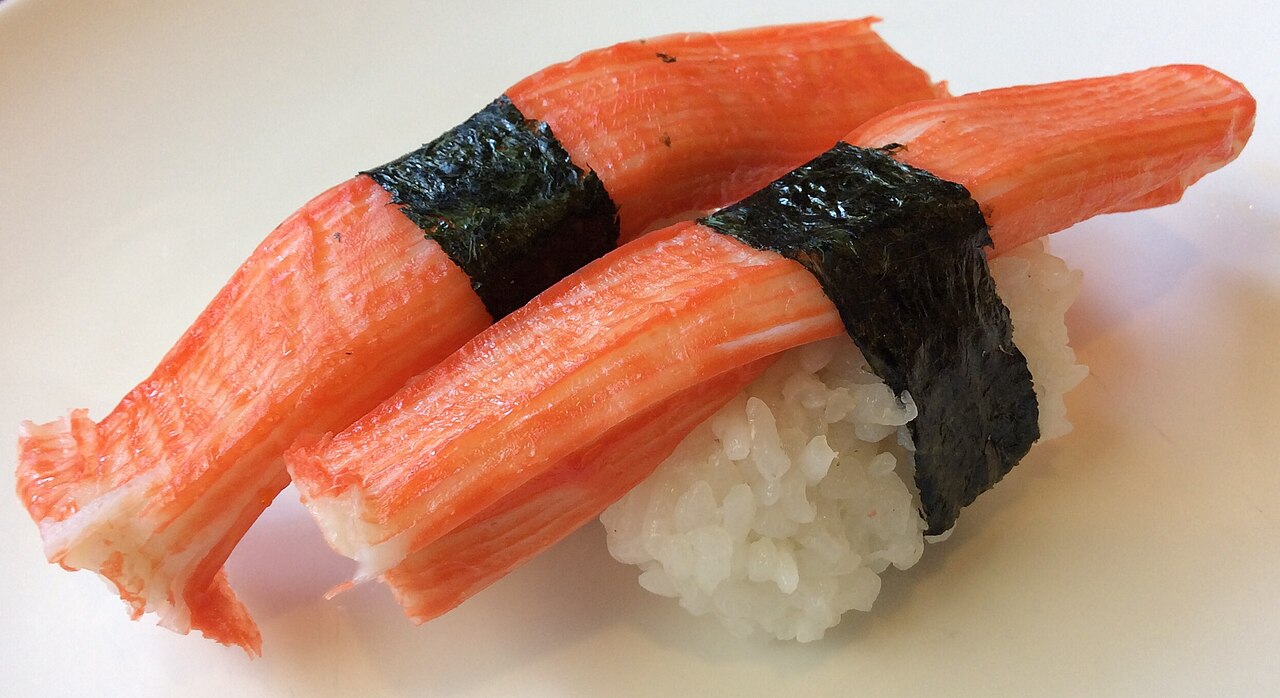.jpg/1280px-Assorted_Nigiri_-2_(9865148706).jpg) |
| Welcome to food porn. |
Nigiri. This is the king of sushi, and consists of oval-shaped balls of rice topped with a slice of another item (typically but not always seafood). Whether or not single-ingredient maki sushi (like Gunkan maki) counts as nigiri could be a point of contention, as technically it is not the same. Single ingredient maki sushi uses a seaweed (nori) wrapper to help bind a more messy/loose ingredient (e.g. various types of roe, chopped up fish) to the top of the rice. Most sushi restaurants simply place these under the "nigiri" list because they are closer to nigiri than the multi-ingredient "rolls" that most basic bitches are used to. I'm going to go ahead and just include these things as nigiri, even if the presence of nori makes them not true nigiri. Losts of lists of types of nigiri include them anyway, so I might as well.
20. Flying Fish / Smelt Roe (Tobiko, Masago) - These things are fine included in rolls to add some color, but they taste like absolutely nothing. Tiny little balls that get stuck in your teeth and provide no flavor. Eh.
19. Jellyfish (Kurage) - I've had this once. The texture was... ahh... interesting.
18. Fluke (Hirami, Ohyo) - Fluke is just fine but nobody goes to get sushi so that they can have some boring-ass flounder.
 |
| Nothing to write home about. It's just okay. |
16. Clam (Akagai, Hokkigai, Mirugai, etc) - I don't dislike clam-based nigiri, but as with jellyfish the texture can take some getting used to. When you eat these things raw, they are quite chewy.
15. Crab (Kani) - Crab is delicious and I love crab, but as nigiri it's just barely better than its imitation relative. There are so many good ways to eat crab and on top of a lump of rice is not anywhere near the top. It can be used better on sushi rolls as a topper than it is as nigiri.
14. Abalone (Awabe) - Similar to the previously mentioned types of clam, but a step up.
| Cooked shrimp is for wimps. I enjoy my mercury raw. |
12. Scallops (Hotate) - I do love me some scallops!
11. Octopus (Tako) - Octopus is best fried up in takoyaki balls, but a chewy, raw piece of octopus on rice can be good too.
10. Squid (Ika) - Basically the same as octopus above, but slightly less chewy in its raw form.
 |
| Yep. It's just egg! |
8.Yellowtail / Amberjack (Hamachi, Buri, Kanpachi) - This is one of the most popular types of sushi in Japan itself, right behind tuna and salmon. There is a reason for this.
7. Mackerel (Saba, Aji) - Probably the most underrated sushi, full of great flavor that a lot of Westerners might think is "too fishy." It's fish, dumbasses. It's supposed to taste fishy.
 |
| Enjoy your gonads! |
Top 5
5. Tuna (Maguro)
I'm breaking the tunas in half for this one, and this is where the entry-level / most common tuna goes. It's pretty delicious and is up there with salmon as the most popular tuna. But for me, it only hits the end of the top 5. Regular cuts of bluefin tuna go (Kuro) in here, as to other tunas like yellowfin (Kihada), bigeye (Mebachi), albacore (Shiro maguro/Binnaga), etc.
4. Eel (Unagi and Anago)
Eel is so good. Freshwater, saltwater. Whatever. I don't understand why people are grossed out by this. It's fish that's long. The same as other fish, but longer.
 |
| Yeah, look at that! |
Yeah, salmon is called "sake" in Japan, which I'm sure confuses a lot of unfamiliar foreigners who are wondering why it has the same name as the rice wine thing. But the kanji is written different (酒 and 鮭 ) and there are internet arguments about whether they are pronounced the same, different, or different but in an indistinguishable way that foreigners wouldn't comprehend. Ignoring that, Salmon is the most popular sushi in the United States and I'll admit it's extremely delicious as nigiri.
 |
| Behold the sea's salty bounty. |
Salmon roe is amazing. Unlike its tiny, tasteless tobiko and masago relatives, ikura are nice-sized balls that pop in your mouth and bleed the salty taste of the ocean into it. I am not kidding. IT TASTES LIKE THE OCEAN. Eating salmon roe is basically temporarily transforms you into Aquaman... or the Gorton's Fisherman... or Poseidon, god of the sea. Something like that. It's also called "red caviar" to differentiate it from black caviar, but in my opinion it's so much tastier than those over-hyped sturgeon eggs.
 |
| This marble is better than Anicent Greek sculptures. |
Fatty tuna belly is the best of the best. It technically comes in different grades like Chūtoro (medium fatty) and Ōtoro (very fatty). It melts on your tongue like butter. There are "fatty" cuts of other sushi like salmon and other tunas that are similar in melting in your mouth deliciousness, but nothing beats the Toro.
No comments:
Post a Comment